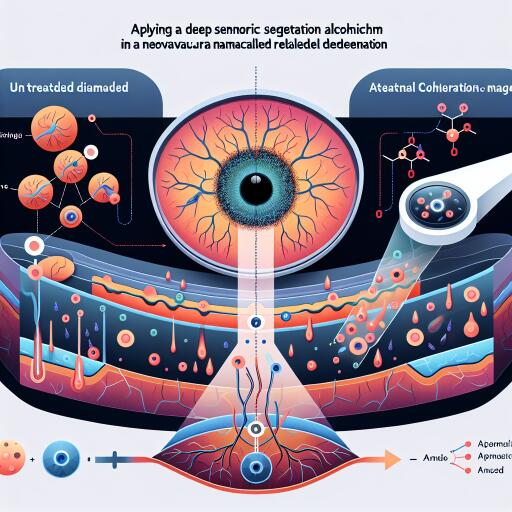Evaluating OCT Biomarker Changes in Neovascular AMD with an Advanced Deep Learning Approach
Age-related macular degeneration (AMD) poses a significant challenge for ophthalmologists worldwide, especially in its neovascular form (nAMD), which can lead to rapid vision loss if not treated promptly. The advent of anti-VEGF therapies has revolutionized treatment, offering hope through intravitreal injections. However, closely monitoring the disease’s progression and the treatment’s efficacy requires precise imaging and analysis. This is where Optical Coherence Tomography (OCT) and the latest deep learning techniques come into play.
Our clinic embarked on a comprehensive study, selecting treatment-naive patients with nAMD in their study eye who had not undergone any prior form of intravitreal injection. These patients were observed over periods extending up to three and twelve months, ensuring a robust follow-up framework. It’s important to note that individuals with comorbidities that could influence OCT results, such as diabetic macular edema or uveitis, were excluded to maintain data integrity.
Following an initial series of traditional examinations, including assessments of best corrected visual acuity (BCVA) and intraocular pressure, patients began a treatment regimen involving three monthly injections of anti-VEGF agents (Ranibizumab, Aflibercept, or Bevacizumab). Subsequently, their treatment intervals were adjusted according to a Treat and Extend regimen.
To analyze the effects of treatment on OCT biomarkers accurately, we turned to deep semantic segmentation algorithms. The creation of this segmentation model began with the meticulous annotation of 458 macular OCT scans by medical retina fellows, under the validation of retinal experts. These annotations were based on 11 OCT labels outlined by the American Academy of Ophthalmology, offering a detailed view of the macular region’s state.
At the heart of our analytical process was a cutting-edge deep convolutional neural network utilizing a U-net architecture, renowned for its effectiveness in medical image analysis. This network underwent rigorous training, optimized through hyperparameter tuning, and was fed annotated images split into distinct training, validation, and test sets. An ensemble of models approach was applied to enhance the prediction accuracy further.
The efficacy of this deep learning model was measured using the F1 score, reflecting the balance between precision and recall in semantic segmentation tasks. Furthermore, the model’s reliability was confirmed by comparing its outputs with a consensus annotation from a panel of experts, showing a remarkable congruence in detecting and classifying nAMD biomarkers.
This deep learning application to OCT scans could automatically segment 18,522 scans from 378 eyes, providing invaluable data on biomarker changes across treatment-naive patients. Through this analysis, our team not only observed the direct impacts of anti-VEGF treatments but also gained insights into the natural progression of nAMD unaffected by previous interventions.
All statistical methods were rigorously applied, assuming normality of data distribution and utilizing the independent samples t-test for analysis. The level of statistical significance was set at p < 0.05.
In the spirit of advancing the field and fostering further research, we plan to make the code for our models, training procedures, and analysis available on a public GitHub repository following publication. This initiative promises to bolster the understanding and treatment of nAMD, showcasing the potent combination of OCT imaging and advanced deep learning technologies in modern ophthalmology.
By harnessing the power of machine learning and high-quality imaging, we stand on the brink of a new era in the diagnosis, monitoring, and treatment of eye diseases, where interventions are not only timely but also precisely targeted to the individual’s condition, thereby preserving vision more effectively than ever before.










